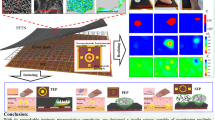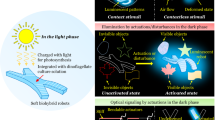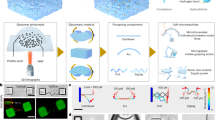Abstract
Natural surfaces that repel foreign matter are ubiquitous and crucial for living organisms. Despite remarkable liquid repellency driven by surface energy in many organisms, repelling tiny solid particles from surfaces is rare. The main challenge lies in the unfavourable scaling of inertia versus adhesion in the microscale and the inability of solids to release surface energy. Here we report a previously unexplored solid repellency on a honeybee’s comb: a catapult-like effect to immediately eject pollen after grooming dirty antennae for self-cleaning. Nanoindentation tests revealed the 38-μm-long comb features a stiffness gradient spanning nearly two orders of magnitude from ~25 MPa at the tip to ~645 MPa at the base. This significantly augments the elastic energy storage and accelerates the subsequent conversion into kinetic energy. The reinforcement in energy storage and conversion allows the particle’s otherwise weak inertia to outweigh its adhesion, thereby suppressing the unfavourable scaling effect and realizing solid repellency that is impossible in conventional uniform designs. We capitalize on this to build an elastomeric bioinspired stiffness-gradient catapult and demonstrate its generality and practicality. Our findings advance the fundamental understanding of natural catapult phenomena with the potential to develop bioinspired stiffness-gradient materials, catapult-based actuators and robotic cleaners.
This is a preview of subscription content, access via your institution
Access options
Access Nature and 54 other Nature Portfolio journals
Get Nature+, our best-value online-access subscription
$29.99 / 30 days
cancel any time
Subscribe to this journal
Receive 12 print issues and online access
$259.00 per year
only $21.58 per issue
Buy this article
- Purchase on Springer Link
- Instant access to full article PDF
Prices may be subject to local taxes which are calculated during checkout




Similar content being viewed by others
Data availability
Source data are provided with this paper.
Code availability
The custom-made code is publicly available at https://github.com/WinnJiang/Bee-code.
References
Barthlott, W. & Neinhuis, C. Purity of the sacred lotus, or escape from contamination in biological surfaces. Planta 202, 1–8 (1997).
Bohn, H. F. & Federle, W. Insect aquaplaning: Nepenthes pitcher plants capture prey with the peristome, a fully wettable water-lubricated anisotropic surface. Proc. Natl Acad. Sci. USA 101, 14138–14143 (2004).
Wong, T.-S. et al. Bioinspired self-repairing slippery surfaces with pressure-stable omniphobicity. Nature 477, 443–447 (2011).
Gao, X. & Jiang, L. Water-repellent legs of water striders. Nature 432, 36–36 (2004).
Hu, D. L., Chan, B. & Bush, J. W. The hydrodynamics of water strider locomotion. Nature 424, 663–666 (2003).
Parker, A. R. & Lawrence, C. R. Water capture by a desert beetle. Nature 414, 33–34 (2001).
Wisdom, K. M. et al. Self-cleaning of superhydrophobic surfaces by self-propelled jumping condensate. Proc. Natl Acad. Sci. USA 110, 7992–7997 (2013).
Bintein, P.-B., Bense, H., Clanet, C. & Quéré, D. Self-propelling droplets on fibres subject to a crosswind. Nat. Phys. 15, 1027–1032 (2019).
Johnson, K. L., Kendall, K. & Roberts, A. Surface energy and the contact of elastic solids. Proc. R. Soc. Lond. A 324, 301–313 (1971).
ElSherbini, A. & Jacobi, A. Retention forces and contact angles for critical liquid drops on non-horizontal surfaces. J. Colloid Interface Sci. 299, 841–849 (2006).
Extrand, C. & Gent, A. Retention of liquid drops by solid surfaces. J. Colloid Interface Sci. 138, 431–442 (1990).
Mukherjee, R., Berrier, A. S., Murphy, K. R., Vieitez, J. R. & Boreyko, J. B. How surface orientation affects jumping-droplet condensation. Joule 3, 1360–1376 (2019).
Jespersen, N. D. & Hyslop, A. Chemistry: The Molecular Nature of Matter (John Wiley, 2021).
Sayyah, A., Horenstein, M. N., Mazumder, M. K. & Ahmadi, G. Electrostatic force distribution on an electrodynamic screen. J. Electrostat. 81, 24–36 (2016).
Hao, K., Tian, Z. X., Wang, Z. C. & Huang, S. Q. Pollen grain size associated with pollinator feeding strategy. Proc. Biol. Sci. 287, 20201191 (2020).
Foose, A., Westwick, R., Vengarai, M. & Rittschof, C. The survival consequences of grooming in the honey bee Apis mellifera. Insectes Soc. 69, 279–287 (2022).
Free, J. B. Insect Pollination of Crops (Academic Press, 1970).
Fard, G. G., Zhang, D., Jimenez, F. L. & Peleg, O. Crystallography of honeycomb formation under geometric frustration. Proc. Natl Acad. Sci. USA 119, e2205043119 (2022).
Mackenzie, D. Proving the perfection of the honeycomb. Science 285, 1338–1339 (1999).
Esch, H. E., Zhang, S., Srinivasan, M. V. & Tautz, J. Honeybee dances communicate distances measured by optic flow. Nature 411, 581–583 (2001).
Seeley, T. D. et al. Stop signals provide cross inhibition in collective decision-making by honeybee swarms. Science 335, 108–111 (2012).
Dong, S., Lin, T., Nieh, J. C. & Tan, K. Social signal learning of the waggle dance in honey bees. Science 379, 1015–1018 (2023).
Lechantre, A. et al. Essential role of papillae flexibility in nectar capture by bees. Proc. Natl Acad. Sci. USA 118, e2025513118 (2021).
Haupt, S. S. Antennal sucrose perception in the honey bee (Apis mellifera L.): behaviour and electrophysiology. J. Comp. Physiol. A 190, 735–745 (2004).
Schönitzer, K. & Renner, M. The function of the antenna cleaner of the honeybee (Apis mellifica). Apidologie 15, 23–32 (1984).
Rebora, M., Salerno, G., Piersanti, S., Michels, J. & Gorb, S. Structure and biomechanics of the antennal grooming mechanism in the southern green stink bug Nezara viridula. J. Insect Physiol. 112, 57–67 (2019).
Hackmann, A., Delacave, H., Robinson, A., Labonte, D. & Federle, W. Functional morphology and efficiency of the antenna cleaner in Camponotus rufifemur ants. R. Soc. Open Sci. 2, 150129 (2015).
Robinson, W. H. “Antennal grooming and movement behaviour in the German cockroach, Blattella germanica (L.),” in Proceedings of the Second International Conference on Urban Pests (ed. Wildey, K.) 361–369 (Exeter Press, 1996).
Longo, S. et al. Beyond power amplification: latch-mediated spring actuation is an emerging framework for the study of diverse elastic systems. J. Exp. Biol. 222, jeb197889 (2019).
Sanz Saiz, C., Polo Martínez, J. & Martín Chivelet, N. Influence of pollen on solar photovoltaic energy: literature review and experimental testing with pollen. Appl. Sci. 10, 4733 (2020).
Noblin, X. et al. The fern sporangium: a unique catapult. Science 335, 1322 (2012).
Edwards, J., Whitaker, D., Klionsky, S. & Laskowski, M. J. A record-breaking pollen catapult. Nature 435, 164–164 (2005).
Ito, S. & Gorb, S. N. Attachment-based mechanisms underlying capture and release of pollen grains. J. R. Soc. Interface 16, 20190269 (2019).
Michels, J. & Gorb, S. N. Detailed three-dimensional visualization of resilin in the exoskeleton of arthropods using confocal laser scanning microscopy. J. Microsc. 245, 1–16 (2012).
Peisker, H., Michels, J. & Gorb, S. N. Evidence for a material gradient in the adhesive tarsal setae of the ladybird beetle Coccinella septempunctata. Nat. Commun. 4, 1661 (2013).
Gorb, S. N. & Filippov, A. E. Fibrillar adhesion with no clusterisation: functional significance of material gradient along adhesive setae of insects. Beilstein J. Nanotechnol. 5, 837–845 (2014).
Patek, S. N., Korff, W. & Caldwell, R. L. Deadly strike mechanism of a mantis shrimp. Nature 428, 819–820 (2004).
Patek, S., Baio, J., Fisher, B. & Suarez, A. Multifunctionality and mechanical origins: ballistic jaw propulsion in trap-jaw ants. Proc. Natl Acad. Sci. USA 103, 12787–12792 (2006).
Büsse, S., Koehnsen, A., Rajabi, H. & Gorb, S. N. A controllable dual-catapult system inspired by the biomechanics of the dragonfly larvae’s predatory strike. Sci. Robot. 6, eabc8170 (2021).
Noblin, X., Yang, S. & Dumais, J. Surface tension propulsion of fungal spores. J. Exp. Biol. 212, 2835–2843 (2009).
Luo, D. et al. Autonomous self-burying seed carriers for aerial seeding. Nature 614, 463–470 (2023).
Ilton, M. et al. The principles of cascading power limits in small, fast biological and engineered systems. Science 360, 397 (2018).
Hawkes, E. W. et al. Engineered jumpers overcome biological limits via work multiplication. Nature 604, 657–661 (2022).
Son, K., Guasto, J. S. & Stocker, R. Bacteria can exploit a flagellar buckling instability to change direction. Nat. Phys. 9, 494–498 (2013).
Majidi, C. Soft robotics: a perspective—current trends and prospects for the future. Soft Robot. 1, 5–11 (2014).
Feldmann, D., Das, R. & Pinchasik, B. E. How can interfacial phenomena in nature inspire smaller robots. Adv. Mater. Interfaces 8, 2001300 (2021).
Li, C., Gorb, S. N. & Rajabi, H. Cuticle sclerotization determines the difference between the elastic moduli of locust tibiae. Acta Biomater. 103, 189–195 (2020).
Vassiliadis, S., Kallivretaki, A. & Provatidis, C. Mechanical modelling of multifilament twisted yarns. Fibers Polym. 11, 89–96 (2010).
Rao, B. N. & Rao, G. V. Large deflections of a nonuniform cantilever beam with end rotational load. Forsch. Ingenieurwes. A 54, 24–26 (1988).
Shvartsman, B. Large deflections of a cantilever beam subjected to a follower force. J. Sound Vib. 304, 969–973 (2007).
Kaliske, M. & Rothert, H. Damping characterization of unidirectional fibre reinforced polymer composites. Compos. Eng. 5, 551–567 (1995).
Rajabi, H. et al. Both stiff and compliant: morphological and biomechanical adaptations of stick insect antennae for tactile exploration. J. R. Soc. Interface 15, 20180246 (2018).
Zabaras, N. & Pervez, T. Viscous damping approximation of laminated anisotropic composite plates using the finite element method. Comput. Methods Appl. Mech. Eng. 81, 291–316 (1990).
Acknowledgements
We acknowledge financial support from the Research Grants Council of Hong Kong (C1006-20W, Z.W.; SRFS2223-1S01, Z.W.; 11215523, Z.W.), the Shenzhen Science and Technology Innovation Council (JCYJ20170413141208098, Z.W.), the Innovation Technology Fund (GHP/021/19SZ, Z.W.), the New Cornerstone Science Foundation through the XPLORER PRIZE (Z.W.), the Meituan Green Tech Award (Z.W.), the National Natural Science Foundation of China (52005075, Z.W.; 52075528, B.W.), and the Shenzhen Science and Technology Program (20220817165030002, J.W.).
Author information
Authors and Affiliations
Contributions
Z.W., J.W. and W.Z. conceived the research. W.Z., C.Z., H.Z. and X.Q. designed the experiments. W.Z., W.J. and C.Z. prepared the samples. W.Z., W.J., C.Z., W.X. and M.C. carried out the experiments. W.Z. and W.J. conducted the dynamics simulation. All authors analysed the data. W.Z., C.Z., Z.W., B.W. and J.W. wrote the paper.
Corresponding authors
Ethics declarations
Competing interests
The authors declare no competing interests.
Peer review
Peer review information
Nature Nanotechnology thanks Bat-El Pinchasik and the other, anonymous, reviewers for their contribution to the peer review of this work.
Additional information
Publisher’s note Springer Nature remains neutral with regard to jurisdictional claims in published maps and institutional affiliations.
Extended data
Extended Data Fig. 1 Occurrence rate of comb cleaning behaviours.
a, Occurrence rate of two immediate behaviours after antennal grooming for honeybees, including comb cleaning and no comb cleaning behaviours. We observed 104 trials of antennal grooming from 10 living honeybee samples. We found that only 26 trials show immediate comb cleaning behaviour, while 78 trials show other subsequent behaviours such as flight, walking, or foraging. Therefore, the average occurrence rate of comb cleaning after antennal grooming for honeybees is 25%. b, Comparison of the occurrence rate of immediate comb cleaning immediately after antennal grooming for four different insects, including honeybees, southern green stink bugs, ants, and cockroaches. The occurrence rate for the honeybees is much lower than the other three insects, indicating that they may possess an unknown ability to keep their comb uncontaminated when grooming dirty antennae.
Extended Data Fig. 2 Scanning electron microscope (SEM) image of the surface of a honeybee’s comb that just performed antennal grooming in natural environments.
Most contaminants, including pollen and dusts, distribute on the middle-to-base part of the comb, leaving the middle-to-tip part almost uncontaminated.
Extended Data Fig. 3 Fraction and distribution of the residual particles of different diameter dp on the comb surface.
a, SEM image of the comb that just groomed the antennae covered with 1-30 μm silica particles. b, Plot of fraction versus \({d}_{{\rm{p}}}\) showing that most residual particles have sizes smaller than 5 μm. c, Plot of \({d}_{{\rm{p}}}\) versus normalized distance \(l/{l}_{0}\) showing that the sizes of particles gradually get larger from the tip to the base of the comb, indicating a location-dependent solid repellency performance. Here \(l/{l}_{0}=0\) denotes the tip and \(l/{l}_{0}=1\) denotes the base of the comb. Data are presented as mean ± s.d. (n = 3).
Extended Data Fig. 4 SEM image of the antennae of a honeybee.
The antennae consist of three parts: scape, pedicel, and flagellum. Note that only the flagellum part is cleaned during the antennal grooming process, and its average diameter is ~209 μm, 32 μm larger than that of the comb.
Extended Data Fig. 5 Measurement of the adhesive force.
a, Typical curves of pull-off adhesive forces on the comb surfaces using silica particles of 5, 10, 15, and 25 μm. The adhesive force can be calculated by the difference in magnitude between the lowest point and the baseline of each curve. It can be found that the adhesive force increases as the particle size gets larger. b, The influence of contact duration on the adhesive force. The adhesive forces for different contact durations are comparable with the maximum difference of 0.3%, indicating the ignorable influence of conduct duration on the adhesive force in the millisecond timescale. Data are presented as mean ± s.d. (n = 5).
Extended Data Fig. 6 Time-dependent acceleration and force analysis for a 10-μm particle adhered to the tip of the comb hair.
a, Comparison between the stiffness gradient comb hair of honeybees (\(\delta =3\)) and the uniform counterpart (\(\delta =0\)) in the deceleration phase. For \(\delta =0\), the acceleration a is relatively small, and the corresponding inertial force \({F}_{{\rm{i}}}\) of the adhered particle is insufficient to overcome \({F}_{{\rm{a}}}\). By contrast, for \(\delta =\)3, the magnitude of a sharply increases, as exemplified by the evident difference in the maximum reverse acceleration, enabling \({F}_{{\rm{i}}}-{F}_{{\rm{a}}}\) to exceed the level of 0 and triggering particle catapult. b, The dynamics of the uniform counterpart. The uniform beam exhibits 2nd order dynamics with time-varying accelerations.
Extended Data Fig. 7 Theoretical calculations.
a, Variation of normalized energy conversion duration with stiffness gradient under three different recovery rates. The good alignment between the three curves suggests that the normalized duration is independent of the recovery rate. b, Location-dependent maximum acceleration of the honeybee’s comb hair. The maximum a rapidly decreases with increasing normalized distance \(l/{l}_{0}\), suggesting that the solid repellency performance degrades from the tip to the base of the honeybee’s comb hair. c, Critical \({d}_{p}\) along the comb hair for three different stiffness gradient coefficients \(\delta\). It can be found that increasing \(\delta\) from 3 (honeybee’s case) to 4 would not give rise to notable enhancement in solid repellency performance relative to the uniform counterpart (\(\delta =0\)), especially for the part of \(l/{l}_{0}\). d, Variation of the contact force between the comb and antennae as a function of \(\delta\). For comparison, the magnitude of the contact force is normalized with respect to that for \(\delta =0\). The normalized contact force shows an exponential growth with increasing \(\delta\), resulting in a sharp increase when \(\delta\) increases from 3 to 4. The increased contact force may damage the antennal function during repeated grooming, which is unfavourable for honeybees.
Extended Data Fig. 8 Comparison of solid repellency performance between (a) the bioinspired SGC-based robot and (b) the control.
Upon sweeping and detaching surfaces covered with 25-μm particles, the SGC-based robot repels considerable amounts of particles adhered to its surface and keeps its surface clean. In contrast, the control fails to repel particles and its surface is heavily contaminated by particles. Scale bars, 10 mm.
Extended Data Fig. 9 Optical images of the self-cleaning solar power system after 12 consecutive cycles of contamination tests.
a, Optical images of surfaces of the SGC-based robot and the contaminated solar panel it cleaned. b, Optical images of surfaces of the control counterparts. In each cycle, we contaminated the solar panel with dust and subsequently actuated the cleaning robots to sweep the solar panel. There is no additional cleaning on the cleaning robots between cycles. Over 12 consecutive cycles, the surface of the SGC-based robot remains clean owing to its superior solid repellency ability and sustains a high cleaning capability to keep the solar panel clean. In striking contrast, the control with poor solid repellency ability is heavily contaminated by dust and unable to efficiently clean the solar panel surface, leaving behind a relatively dirty solar panel. Scale bars, 10 mm.
Extended Data Fig. 10 Optical images of the contact status between the plates and the solar panel surfaces from side view.
a, Optical images of the SGC-based robot at cycle 1 and cycle 12. b, Optical images of the control at cycle 1 and cycle 12. Scale bars, 10 mm.
Supplementary information
Supplementary Video 1
Natural antennal grooming behaviour of a honeybee when visiting flowers.
Supplementary Video 2
High-speed video of the solid repellency phenomenon in honeybee during its antennal grooming behaviour. The video was recorded at 1,000 f.p.s. and is shown at 30 f.p.s.
Supplementary Video 3
Application demonstration of the SGC-based robot.
Source data
Source Data Fig. 1
Statistical source data.
Source Data Fig. 2
Statistical source data.
Source Data Fig. 3
Statistical source data.
Source Data Fig. 4
Statistical source data.
Source Data Extended Data Fig. 1
Statistical source data.
Source Data Extended Data Fig. 3
Statistical source data.
Source Data Extended Data Fig. 5
Statistical source data.
Source Data Extended Data Fig. 6
Statistical source data.
Source Data Extended Data Fig. 7
Statistical source data.
Rights and permissions
Springer Nature or its licensor (e.g. a society or other partner) holds exclusive rights to this article under a publishing agreement with the author(s) or other rightsholder(s); author self-archiving of the accepted manuscript version of this article is solely governed by the terms of such publishing agreement and applicable law.
About this article
Cite this article
Zhang, W., Jiang, W., Zhang, C. et al. Honeybee comb-inspired stiffness gradient-amplified catapult for solid particle repellency. Nat. Nanotechnol. 19, 219–225 (2024). https://doi.org/10.1038/s41565-023-01524-x
Received:
Accepted:
Published:
Issue Date:
DOI: https://doi.org/10.1038/s41565-023-01524-x



